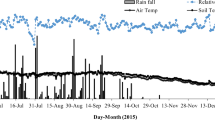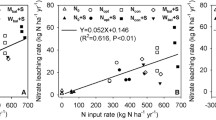Abstract
The leaching behavior of nitrogen was studied in single rice paddy production ecosystems in Tsukuba, Japan after 75 years of consistent fertilization regimes (no fertilizer, ammonium sulfate, a combination of composted rice straw with soybean cake, and fresh clover). During the 75-year period, management was unchanged with respect to rice planting density, irrigation, and net N fertilization for each field to which an N-source was added. Percolation water was collected, from May 2001 to April 2002, using porous suction cups installed in the fields at depths of 15, 40, and 60 cm. All water samples were taken to the laboratory for the measurement of both NH4 + –N and NO3 − –N concentrations using a continuous-flow nitrogen analyzer. The result indicated that there were significant differences in N leaching losses between treatments during the rice growing season. Total N leaching was significantly lower with the application of composted rice straw plus soybean cake (0.58 kg N ha − 1) than with ammonium sulfate (2.41 kg N ha − 1), which resulted in N leaching at a similar level to that with the fresh clover treatment (no significant difference). The majority of this N leaching was not due to NO3 − –N loss, but to that of NH4 + –N. The mean N leaching for all fertilizer treatments during the entire rice growing season was 1.58 kg N ha − 1. Composted rice straw plus soybean cake produced leaching losses which were 65–75% lower than those with the application of fresh clover and ammonium sulfate. N accumulation resulting from nitrification in the fallow season could be a key source of nitrate–N leaching when fields become re-flooded before rice transplanting in the following year; particular attention should be paid to this phenomenon.
Similar content being viewed by others
References
Bi, L. D., Zhang, B., Liu, G. R., Li, Z. Z., Liu, Y. R., Ye, C., et al. (2006). Long-term effects of organic amendments on the rice yields for double rice cropping systems in subtropical China. Agriculture, Ecosystems & Environment, 129, 534–541.
Bijay, S., Yadvinder, S., Khind, C. S., Meelu, O. P., Singh, B., & Singh, Y. (1991). Leaching losses of urea-N applied to permeable soils under lowland rice. Fertilizer Research, 28, 179–184.
Cao, L. K., Chen, G. J., & Lu, Y. T. (2005). Nitrogen leaching in vegetable fields in the suburbs of Shanghai. Pedosphere, 15, 641–645.
Cookson, W., Rowarth, J., & Cameron, K. (2000). The effect of autumn applied 15N-labelled fertilizer on nitrate leaching in a cultivated soil during winter. Nutrient Cycling in Agroecosystems, 56, 99–107.
De Paz, J. M., Delgado, J. A., Ramos, C., Shaffer, M. J., & Barbarick, K. K. (2009). Use of a new nitrogen index-GIS assessment for evaluation of nitrate leaching across a Mediterranean region. Journal of Hydrology, 365, 183–194.
Di, H., & Cameron, K. (2002). Nitrate leaching in temperate agroecosystems: Sources, factors and mitigating strategies. Nutrient Cycling in Agroecosystems, 64, 237–256.
Fisher, N. (1989). The state of the Chesapeake Bay, third biennial monitoring report, data analysis work group of the Chesapeake Bay Programs Monitoring Subcommittee: 33.
Fletcher, D. A. (1991). A national perspective. In: R. F. Flleff, D. R. Keeney, & R. M. Cruse (Eds.), Managing groundwater quality and farm profitability (pp. 9–17). Madison: SSSA.
Fumihiko, A. (1997). The estimation of evapotranspiration on rice in Daogen county under global warming condition. Japan Crops Association Report, 38.
Grossmann, J., & Udluft, P. (1991). The extraction of soil water by suction cup method: A review. Journal of Soil Science, 42, 3–93.
Johnston, A. E. (2007). Potassium, magnesium and soil fertility: Long-term experimental evidence. Proceedings/ International Fertilizer Society, 613, 1–39.
Johnston, A. E., Poulton, P. R., & Coleman, K. (2009). Soil organic matter: Its importance in sustainable agriculture and carbon dioxide fluxes. Advances in Agronomy, 101, 1–57.
Jorge, A. D., Stephen, J. D., & Stephen, M. O. (2010). 15N isotopic crop residue cycling studies and modeling suggest that IPCC methodologies to assess residue contributions to N2O–N emissions should be reevaluated. Nutrient Cycling Agroecosystems, 86, 383–390.
Katoh, M., Iwata, A., Shaku, I., Nakajima, Y., Matsuya, K., & Kimura, M. (2003). Impact of water percolation on nutrient leaching from an irrigated paddy field in Japan. Soil Use and Management, 19, 298–304.
Kazutake, K. (1995). Ecological sustainability of the paddy soil-rice system in Asia. From international seminar on the appropriate use of fertilizers. Taiwan ROC, November 6–14.
Kikuo, K. (2002). Nitrogen fertilization and nitrate pollution in groundwater in Japan: Present status and measures for sustainable agriculture. Nutrient Cycling in Agroecosystems, 63, 1385–1314.
Kirchmann, H., & Bergström, L. (2001). Do organic farming practices reduce nitrate leaching? Communications in Soil Science and Plant Analysis, 32, 997–1208.
Leigh, R. A., & Johnston, A. E. (1994). Long-term experiments in agricultural and ecological sciences. Harpenden: CAB.
Litaor, M. I. (1988). Review of soil solution samplers. Water Resource Research, 5, 727–733.
Luo, L. G., Wen, D. Z., & Shen, S. M. (2000). Study on the percolation regularity of nutrient in rice field ecosystem of northern China. Scientia Agricultura Sinica, 2, 68–74.
Oquist, K. A., Strock, J. S., & Mulla, D. J. (2007). Influence of alternative and conventional farming practices on subsurface drainage and water quality. Journal of Environmental Quality, 36, 1194–1204.
Pampolino, M. F., Urushiyama, T., & Hatano, R. (2000). Detection of nitrate leaching through bypass flow using pan lysimeter, suction cup, and resin capsule. Soil Science and Plant Nutrition, 46, 703–712.
Panda, D., Mahata, K. R., Sen, H. S., & Patnaik, S. (1989). Transformation and loss of nitrogen due to leaching and ammonia volatilization in wetland rice (Oryza sativa) soil. Indian Journal of Agricultural Science, 59, 291–296.
Phillips, I., & Burton, E. (2005). Nutrient leaching in undisturbed cores of an acidic sandy Podosol following simultaneous potassium chloride and di-ammonium phosphate application. Nutrient Cycling Agroecosystems, 73, 1–14.
Ray, C. (2001). Managing nitrate problems for domestic wells in irrigated alluvial, aquifers. Journal of Irrigation and Drainage Engineering, 1, 49–53.
SAS Institute Inc (1999). SAS 8.01 for Windows. Cary: SAS.
Schröder, J. J. (2005). Revisiting the agronomic benefits of manure: A correct assessment and exploitation of its fertilizer value spares the environment. Bioresource Technology, 96, 253–261.
Tisdale, S. L., Nelson, W. L., & Beaton, J. D. (1993). Soil Fertility and Fertilizers. New York: McMillan.
Tong, Y., Ove, E., Lu, D., & Harald, G. (1997). Effect of organic manure and chemical fertilizer on nitrogen uptake and nitrate leaching in a Eumorthic anthrosols profile. Nutrient Cycling in Agroecosystems, 48, 225–229.
Torstensson, G., & Aronsson, H. (2000). Nitrogen leaching and crop availability in manured catch crop systems in Sweden. Nutrient Cycling Agroecosystems, 56, 139–152.
USEPA (2003). United States Environmental Protection Agency, Drinking Water quality Standards. In Consumer fact sheet on nitrates/nitrites. Washington, DC: USEPA.
Wang, J., Wang, S., & Chen, Y. (1995). Leaching loss of nitrogen in double-rice-cropped paddy fields in China. Acta Agriculturae Zhejiangensis, 7, 155–160.
Xie, Y. X., Xiong, Z. Q., Xing, G. X., Sun, G. Q., & Zhu, Z. L. (2007). An assessment of nitrogen pollutant sources in surface water in Taihu region. Pedosphere, 17, 200–208.
Xing, G. X., & Zhu, Z. L. (2000). An assessment of N loss from agricultural fields to the environment in China. Nutrient Cycling Agroecosystems, 57, 67–73.
Author information
Authors and Affiliations
Corresponding author
Rights and permissions
About this article
Cite this article
Luo, Lg., Itoh, S., Zhang, Qw. et al. Leaching behavior of nitrogen in a long-term experiment on rice under different N management systems. Environ Monit Assess 177, 141–150 (2011). https://doi.org/10.1007/s10661-010-1624-z
Received:
Accepted:
Published:
Issue Date:
DOI: https://doi.org/10.1007/s10661-010-1624-z




